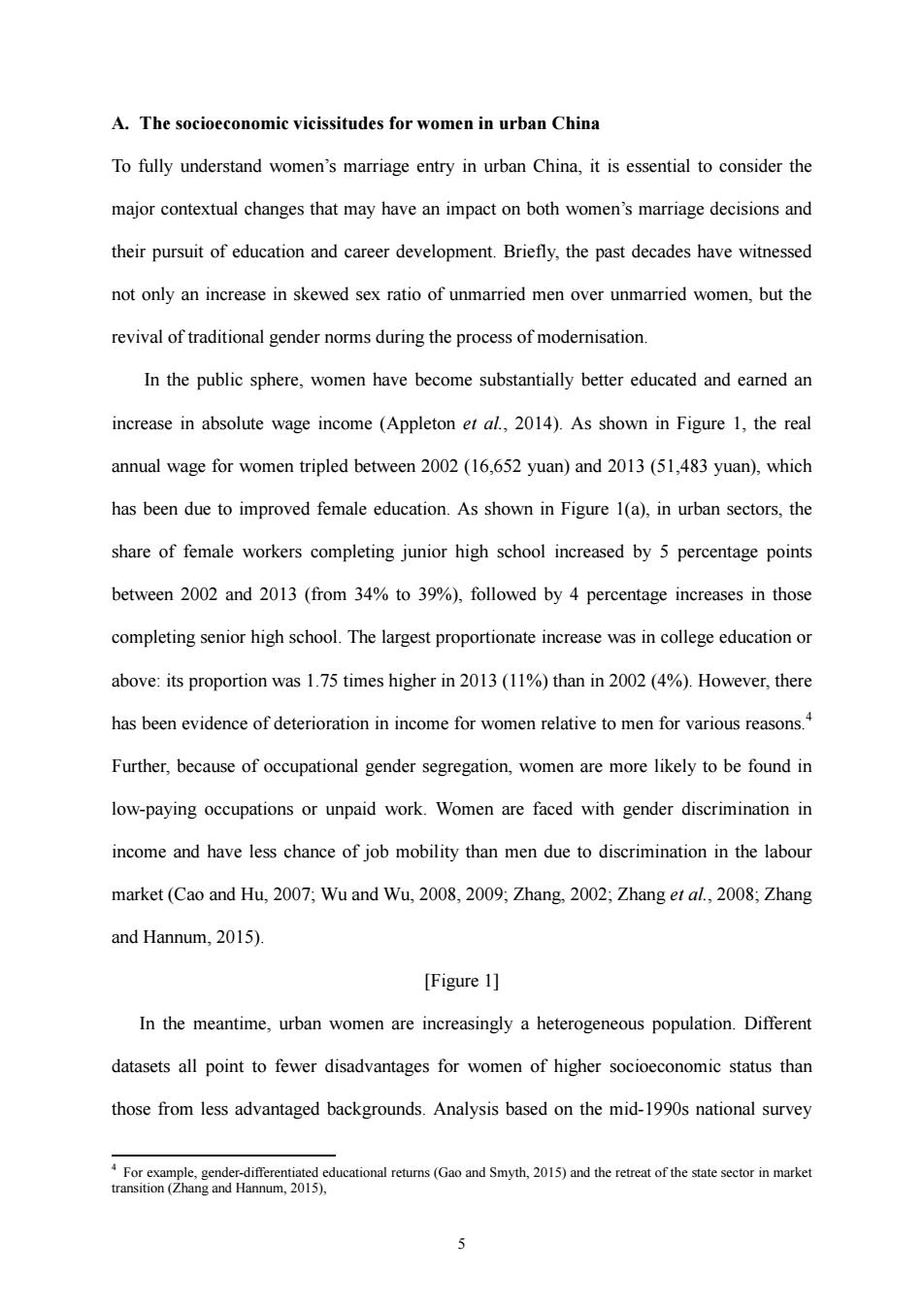正在加载图片...

A.The socioeconomic vicissitudes for women in urban China To fully understand women's marriage entry in urban China,it is essential to consider the major contextual changes that may have an impact on both women's marriage decisions and their pursuit of education and career development.Briefly,the past decades have witnessed not only an increase in skewed sex ratio of unmarried men over unmarried women,but the revival of traditional gender norms during the process of modernisation. In the public sphere,women have become substantially better educated and earned an increase in absolute wage income (Appleton et al.,2014).As shown in Figure 1,the real annual wage for women tripled between 2002(16,652 yuan)and 2013(51,483 yuan),which has been due to improved female education.As shown in Figure 1(a),in urban sectors,the share of female workers completing junior high school increased by 5 percentage points between 2002 and 2013(from 34%to 39%),followed by 4 percentage increases in those completing senior high school.The largest proportionate increase was in college education or above:its proportion was 1.75 times higher in 2013(11%)than in 2002(4%).However,there has been evidence of deterioration in income for women relative to men for various reasons.4 Further,because of occupational gender segregation,women are more likely to be found in low-paying occupations or unpaid work.Women are faced with gender discrimination in income and have less chance of job mobility than men due to discrimination in the labour market(Cao and Hu,2007:Wu and Wu,2008,2009;Zhang,2002;Zhang et al.,2008;Zhang and Hannum,2015). [Figure 1] In the meantime,urban women are increasingly a heterogeneous population.Different datasets all point to fewer disadvantages for women of higher socioeconomic status than those from less advantaged backgrounds.Analysis based on the mid-1990s national survey 4For example,gender-differentiated educational retums(Gao and Smyth,2015)and the retreat of the state sector in market transition (Zhang and Hannum,2015),5 A. The socioeconomic vicissitudes for women in urban China To fully understand women’s marriage entry in urban China, it is essential to consider the major contextual changes that may have an impact on both women’s marriage decisions and their pursuit of education and career development. Briefly, the past decades have witnessed not only an increase in skewed sex ratio of unmarried men over unmarried women, but the revival of traditional gender norms during the process of modernisation. In the public sphere, women have become substantially better educated and earned an increase in absolute wage income (Appleton et al., 2014). As shown in Figure 1, the real annual wage for women tripled between 2002 (16,652 yuan) and 2013 (51,483 yuan), which has been due to improved female education. As shown in Figure 1(a), in urban sectors, the share of female workers completing junior high school increased by 5 percentage points between 2002 and 2013 (from 34% to 39%), followed by 4 percentage increases in those completing senior high school. The largest proportionate increase was in college education or above: its proportion was 1.75 times higher in 2013 (11%) than in 2002 (4%). However, there has been evidence of deterioration in income for women relative to men for various reasons.4 Further, because of occupational gender segregation, women are more likely to be found in low-paying occupations or unpaid work. Women are faced with gender discrimination in income and have less chance of job mobility than men due to discrimination in the labour market (Cao and Hu, 2007; Wu and Wu, 2008, 2009; Zhang, 2002; Zhang et al., 2008; Zhang and Hannum, 2015). [Figure 1] In the meantime, urban women are increasingly a heterogeneous population. Different datasets all point to fewer disadvantages for women of higher socioeconomic status than those from less advantaged backgrounds. Analysis based on the mid-1990s national survey 4 For example, gender-differentiated educational returns (Gao and Smyth, 2015) and the retreat of the state sector in market transition (Zhang and Hannum, 2015)